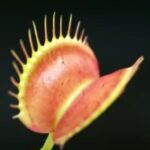As an Amazon Associate, this site earns commissions from qualifying purchases. For more details, click here.
There is a common belief that Venus flytraps are difficult to grow especially indoors. The truth is anyone can do it as long as you meet the basic requirements. This article shows you how straightforward caring for Venus flytraps is indoors.
Venus flytraps can grow indoors as long as they have access to light, water and insects. Use 1 part sphagnum moss and 1 part sand for the soil and place the container on a window sill with indirect sunlight.
How to Grow Venus Flytraps Indoors
Venus flytraps differ from other houseplants not just because they eat insects but their soil requirements are more specific. It is not expensive by any means, just different from the typical houseplant.
What You Need
- Soil: a ready made solution is Organic Earth Soil. You can also mix sphagnum moss and sand. You can also try perlite or peat instead of sand.
- Water: distilled water is the best option. You can also use reverse osmosis water or collect rainwater.
- Sunlight or artificial light are both okay. There are a lot of grow lights but our choice is KEELIXIN Grow Lights.
- Pot or any container, 4-6 inches deep with drainage
- Good air circulation
- Nutrients, live or dead insects. Freeze dried worms or fish food will be fine also.
How Much Light Do Venus Flytraps Need?
You can use artificial lights indoors, but you can also place the container on a window where it can catch some sun. Bright, indirect light is ideal. Keep the plant away from intense direct sunlight as it could damage the traps and cause discoloration.
Venus flytraps need 8-12 hours of indirect sunlight. The absolute minimum is 6 hours, but that will slow their growth. It might be enough for the plant to survive, but do not expect large traps to appear.
If using artificial lights, keep your Venus flytrap at least seven inches away. The light must be indirect and must be on for 12 hours a day.
How can you tell if the plant is getting enough light? If the insides of its traps are reddish pink and the leaves are thick, there is enough light.
If you see long thin leaves and pale traps, increase the light intensity. Note that if you are relying on sunlight, reposition the pot so it gets more light.
How Much Water Do Venus Flytraps Need?
Venus flytraps need lots of water, but do not overdo it. It is possible to overwater a Venus flytrap and make it vulnerable to root rot and fungal infection.
Keep the soil moist, but not soaked. Press your thumb in the soil. If a few bits of moss stick, that is fine. If water comes up, the soil is too wet. A simpler way is to use a device like Sonkir Soil PH Meter to check the moisture.
During summer you might need to water Venus flytraps twice a day. Around fall, water once a day might be enough. The plant is dormant at winter so watering once a month should be enough.
For spring, summer and fall (as long as the plant has not yet entered dormancy), you can use the tray method.
Get a pot with drainage holes and a tray. Place your Venus flytrap in the pot. Put the pot on the tray and add an inch of water.
The taller the pot, the more water you should add, but for 6 inch pots an inch of water is fine. If you are not sure of the water level, err on the side o caution. You can always add more later.
Aside from water and sunlight, Venus flytraps will also benefit from plenty of air. Keep your window open or leave a fan running. Ideally the area should be humid but temperatures will change, so keep the soil moist.
Do not let the soil dry. Refill the tray with water once the water is almost gone. And as pointed out earlier, use only distilled water or reverse osmosis water. You can also gather rainwater if neither of the two is possible.
Tap water should be avoided because they contain minerals that could harm the plant. By using distilled water, you are making sure your Venus flytrap grows healthy.
What to Feed Venus Flytraps
Venus flytraps eat flies, spiders, small beetles, crickets and other bugs. If your flytrap is outdoors they can fend for their own so no need to do anything. Indoors however, you have to supply the plant with these bugs.
Indoor Venus flytraps might catch an occasional fly or two, but it needs about 3-5 bugs a month. Fortunately these plants eat dead bugs, so you can buy freeze dried crickets or fish food and keep the plant nourished.
A Venus flytrap only eats living prey, but there are ways you can make it digest dead bugs, and it will not harm the plant. First we need to understand how Venus flytraps catch live prey and how you can make it eat dead insects.
Each trap on a Venus flytrap has sensors built in. When a bug lands on the trap and touches the sensors twice, the trap shuts. The trap will only close if these sensors are triggered two times and if the bug is small enough to be captured.
Dead bugs cannot trigger those sensors, so you have to do it. First, place a bug in the trap, careful not to set off the hair sensors too early.
Once the insect is inside, use a stick or other object to tap the sensors twice. These are sensitive so it will not take a lot of prodding.
Venus flytraps can also digest fish food, mealworms and other small insects. Do not give it cockroaches, beetles or other bugs with hard shells. Remember to slice the bugs into small pieces, totaling about one third the size of the trap.
What to Do When Venus Flytraps Enter Dormancy
The plant should be in a room with temperature ranging from 35-50F (-15C to 10C). When Venus flytraps enter dormancy, they discard leaves and look dead. But they are not, so be patient and wait for their return in spring.
Do not use the tray method during dormancy. Water the soil every two weeks or every month. Your goal is to keep the soil moist, so this is less about the frequency and more about reaching that objective. When spring comes, slowly move up its exposure to sunlight. Be patient as the plant will slowly get used to the sun again.
How Big Do Indoor Venus Flytraps Get?
Indoor Venus flytraps can reach a height of 5 inches, and each trap 1-1.5 inches long. Larger flytraps can grow 2 inch traps. The healthier the plant is, the faster and larger it will grow.
Though there are some exceptions, 5 inches is the maximum height for most Venus flytraps. The key is to ensure the plant receives enough light, water, air and food. You also have to use the right soil so the plant grows.
Houseplants need nutrient rich soil to grow, but that would kill Venus flytraps. These plants prefer nutrient poor soil because that is how they grow in the wild.
No one knows for sure why these carnivorous plants grow there. But what is certain is that Venus flytraps developed traps so they can obtain nutrients elsewhere. Since they cannot get nitrogen and other elements from the soil, they get it from flies, ants and other insects.
Your indoor Venus flytraps have to grow in the same manner. Planting them in rich soil and feeding them bugs is going to hurt or kill it.
These plants are used to getting their nutrients from insects, so your indoor setup needs to simulate the wild as much as possible.
Overfeeding your Venus flytrap will not make it grow any faster or larger. If you want larger traps, give one trap a bug to digest. After 5-12 days and the trap opens, you can feed it again.
Do this with just one trap. Feeding too many at once could weaken the plant. And remember to cut the flower stalk to prevent the plant from blooming. This allows the plant to produce larger traps.
Conclusion
Hopefully this guide was able to show you that caring for Venus flytraps indoors is not that hard. The reason many have a difficult time growing these plants is not using the right approach. If you follow the guidelines above, expect your Venus flytraps to live long and healthy.

My fascination with carnivorous plants began many, many years ago with Venus Fly Traps. Now I am more than happy to impart what I know with other enthusiasts and those who are curious about meat eating plants.



